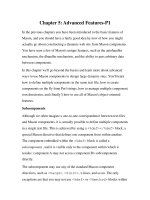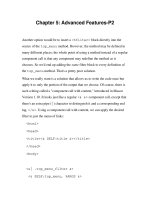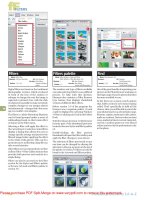5.EIGRP advanced features
Bạn đang xem bản rút gọn của tài liệu. Xem và tải ngay bản đầy đủ của tài liệu tại đây (987.7 KB, 38 trang )
Configuring EIGRP
Introducing EIGRP
BSCI v3.0—2-1
EIGRP Route Summarization: Automatic
• Purpose: Smaller routing tables, smaller updates
• Automatic summarization:
– On major network boundaries, subnetworks are
summarized to a single classful (major) network.
– Automatic summarization occurs by default.
EIGRP Route Summarization: Manual
Manual summarization has the following
characteristics:
• Summarization is configurable on a per-interface basis in any
router within a network.
• When summarization is configured on an interface, the router
immediately creates a route pointing to null0.
– Loop-prevention mechanism
• When the last specific route of the summary goes away, the
summary is deleted.
• The minimum metric of the specific routes is used as the
metric of the summary route.
Configuring Route Summarization
(config-router)#
no auto-summary
• Turns off automatic summarization for the EIGRP process
(config-if)#
ip summary-address eigrp as-number address mask
[admin-distance]
• Creates a summary address that this interface will generate
Manually Summarizing EIGRP Routes
Router C Routing Table
RouterC#show ip route
<output omitted>
Gateway of last resort is not set
172.16.0.0/16 is variably subnetted, 3 subnets, 2 masks
D
172.16.0.0/16 is a summary, 00:00:04, Null0
D
172.16.1.0/24 [90/156160] via 10.1.1.2, 00:00:04, FastEthernet0/0
D
172.16.2.0/24 [90/20640000] via 10.2.2.2, 00:00:04, Serial0/0/1
C
192.168.4.0/24 is directly connected, Serial0/0/0
10.0.0.0/8 is variably subnetted, 3 subnets, 2 masks
C
10.2.2.0/24 is directly connected, Serial0/0/1
C
10.1.1.0/24 is directly connected, FastEthernet0/0
D
10.0.0.0/8 is a summary, 00:00:05, Null0
RouterC#
Configuring WAN Links
• EIGRP supports different WAN links:
– Point-to-point links
– NBMA
• Multipoint links
• Point-to-point links
• EIGRP uses up to 50% of
bandwidth by default; this
bandwidth utilization can
be changed.
EIGRP WAN Configuration:
Frame Relay Hub-and-Spoke Topology
• Configure each virtual Circuit as point-to-point, specify bandwidth = 1/10 of link capacity
• Increase EIGRP utilization to 50% of actual VC capacity
Router Authentication
• Many routing protocols support authentication such that a
router authenticates the source of each routing update
packet that it receives.
• Simple password authentication is supported by:
– IS-IS
– OSPF
– RIPv2
• MD5 authentication is supported by:
– OSPF
– RIPv2
– BGP
– EIGRP
Simple Password vs. MD5 Authentication
• Simple password authentication:
– Router sends packet and key.
– Neighbor checks whether key matches its key.
– Process not secure.
• MD5 authentication:
– Configure a key (password) and key ID; router generates a
message digest, or hash, of the key, key ID and message.
– Message digest is sent with packet; key is not sent.
– Process OS secure.
EIGRP MD5 Authentication
• EIGRP supports MD5 authentication.
• Router generates and checks every EIGRP packet. Router
authenticates the source of each routing update packet that it
receives.
• Configure a key (password) and key ID; each participating
neighbor must have same key configured.
MD5 Authentication
EIGRP MD5 authentication:
• Router generates a message digest, or hash, of the key,
key ID, and message.
• EIGRP allows keys to be managed using key chains.
• Specify key ID (number), key, and lifetime of key.
• First valid activated key, in order of key numbers, is used.
Configuring EIGRP MD5 Authentication
Router(config-if)#
ip authentication mode eigrp autonomous-system md5
• Specifies MD5 authentication for EIGRP packets
Router(config-if)#
ip authentication key-chain eigrp autonomous-system
name-of-chain
• Enables authentication of EIGRP packets using key in the
keychain
Configuring EIGRP MD5 Authentication
(Cont.)
Router(config)#
key chain name-of-chain
• Enters configuration mode for the keychain
Router(config-keychain)#
key key-id
• Identifies key and enters configuration mode for the keyid
Configuring EIGRP MD5 Authentication
(Cont.)
Router(config-keychain-key)#
key-string text
• Identifies key string (password)
Router(config-keychain-key)#
accept-lifetime start-time {infinite | end-time | duration
seconds}
• Optional: Specifies when key will be accepted for received
packets
Router(config-keychain-key)#
send-lifetime start-time {infinite | end-time | duration
seconds}
• Optional: Specifies when key can be used for sending packets
Example MD5 Authentication Configuration
R1 Configuration for MD5 Authentication
<output omitted>
key chain R1chain
key 1
key-string firstkey
accept-lifetime 04:00:00 Jan 1 2006 infinite
send-lifetime 04:00:00 Jan 1 2006 04:01:00 Jan 1 2006
key 2
key-string secondkey
accept-lifetime 04:00:00 Jan 1 2006 infinite
send-lifetime 04:00:00 Jan 1 2006 infinite
<output omitted>
interface FastEthernet0/0
ip address 172.16.1.1 255.255.255.0
!
interface Serial0/0/1
bandwidth 64
ip address 192.168.1.101 255.255.255.224
ip authentication mode eigrp 100 md5
ip authentication key-chain eigrp 100 R1chain
!
router eigrp 100
network 172.16.1.0 0.0.0.255
network 192.168.1.0
auto-summary
R2 Configuration for MD5 Authentication
<output omitted>
key chain R2chain
key 1
key-string firstkey
accept-lifetime 04:00:00 Jan 1 2006 infinite
send-lifetime 04:00:00 Jan 1 2006 infinite
key 2
key-string secondkey
accept-lifetime 04:00:00 Jan 1 2006 infinite
send-lifetime 04:00:00 Jan 1 2006 infinite
<output omitted>
interface FastEthernet0/0
ip address 172.17.2.2 255.255.255.0
!
interface Serial0/0/1
bandwidth 64
ip address 192.168.1.102 255.255.255.224
ip authentication mode eigrp 100 md5
ip authentication key-chain eigrp 100 R2chain
!
router eigrp 100
network 172.17.2.0 0.0.0.255
network 192.168.1.0
auto-summary
Verifying MD5 Authentication
R1#
*Jan 21 16:23:30.517: %DUAL-5-NBRCHANGE: IP-EIGRP(0) 100: Neighbor
192.168.1.102 (Serial0/0/1) is up: new adjacency
R1#show ip eigrp neighbors
IP-EIGRP neighbors for process 100
H
Address
Interface
Hold Uptime
SRTT
(sec)
(ms)
12 00:03:10
17
RTO
Q Seq
Cnt Num
2280 0 14
0
192.168.1.102
Se0/0/1
R1#show ip route
<output omitted>
Gateway of last resort is not set
D
172.17.0.0/16 [90/40514560] via 192.168.1.102, 00:02:22, Serial0/0/1
172.16.0.0/16 is variably subnetted, 2 subnets, 2 masks
D
172.16.0.0/16 is a summary, 00:31:31, Null0
C
172.16.1.0/24 is directly connected, FastEthernet0/0
192.168.1.0/24 is variably subnetted, 2 subnets, 2 masks
C
192.168.1.96/27 is directly connected, Serial0/0/1
D
192.168.1.0/24 is a summary, 00:31:31, Null0
R1#ping 172.17.2.2
Type escape sequence to abort.
Sending 5, 100-byte ICMP Echos to 172.17.2.2, timeout is 2 seconds:
!!!!!
Success rate is 100 percent (5/5), round-trip min/avg/max = 12/15/16 ms
Troubleshooting MD5 Authentication
R1#debug eigrp packets
EIGRP Packets debugging is on
(UPDATE, REQUEST, QUERY, REPLY, HELLO, IPXSAP, PROBE, ACK, STUB, SIAQUERY,
SIAREPLY)
*Jan 21 16:38:51.745: EIGRP: received packet with MD5 authentication, key id = 1
*Jan 21 16:38:51.745: EIGRP: Received HELLO on Serial0/0/1 nbr 192.168.1.102
*Jan 21 16:38:51.745:
AS 100, Flags 0x0, Seq 0/0 idbQ 0/0 iidbQ un/rely 0/0 pe
erQ un/rely 0/0
R2#debug eigrp packets
EIGRP Packets debugging is on
(UPDATE, REQUEST, QUERY, REPLY, HELLO, IPXSAP, PROBE, ACK, STUB, SIAQUERY,
SIAREPLY)
R2#
*Jan 21 16:38:38.321: EIGRP: received packet with MD5 authentication, key id = 2
*Jan 21 16:38:38.321: EIGRP: Received HELLO on Serial0/0/1 nbr 192.168.1.101
*Jan 21 16:38:38.321:
AS 100, Flags 0x0, Seq 0/0 idbQ 0/0 iidbQ un/rely 0/0 pe
erQ un/rely 0/0
Troubleshooting MD5 Authentication
Problem
MD5 authentication on both R1 and R2, but R1 key 2 (that it uses when
sending) changed
R1(config-if)#key chain R1chain
R1(config-keychain)#key 2
R1(config-keychain-key)#key-string wrongkey
R2#debug eigrp packets
EIGRP Packets debugging is on
(UPDATE, REQUEST, QUERY, REPLY, HELLO, IPXSAP, PROBE, ACK, STUB, SIAQUERY,
SIAREPLY)
R2#
*Jan 21 16:50:18.749: EIGRP: pkt key id = 2, authentication mismatch
*Jan 21 16:50:18.749: EIGRP: Serial0/0/1: ignored packet from 192.168.1.101, opc
ode = 5 (invalid authentication)
*Jan 21 16:50:18.749: EIGRP: Dropping peer, invalid authentication
*Jan 21 16:50:18.749: EIGRP: Sending HELLO on Serial0/0/1
*Jan 21 16:50:18.749:
AS 100, Flags 0x0, Seq 0/0 idbQ 0/0 iidbQ un/rely 0/0
*Jan 21 16:50:18.753: %DUAL-5-NBRCHANGE: IP-EIGRP(0) 100: Neighbor 192.168.1.101
(Serial0/0/1) is down: Auth failure
R2#show ip eigrp neighbors
IP-EIGRP neighbors for process 100
R2#
EIGRP Query Process
• Queries are sent when a route is lost and no feasible
successor is available.
• The lost route is now in active state.
• Queries are sent to all neighboring routers on all interfaces
except the interface to the successor.
• If the neighbors do not have the lost-route information,
queries are sent to their neighbors.
• If a router has an alternate route, it answers the query; this
stops the query from spreading in that branch of the network.
Updates and Queries in Hub-and-Spoke
Topology
You do not want to use these paths!
EIGRP Stub
• The EIGRP stub routing feature improves network stability,
reduces resource utilization, and simplifies remote router
(spoke) configuration.
• Stub routing is commonly used in a hub-and-spoke topology.
• A stub router sends a special peer information
packet to all neighboring routers to report its status
as a stub router.
• A neighbor that receives a packet informing it of the stub
status does not query the stub router for any routes.
Configuring EIGRP Stub
Router(config-router)#
eigrp stub [receive-only|connected|static|summary]
• receive-only: Prevents the stub from sending any type of
route.
• connected: Permits stub to send connected routes
(may still need to redistribute).
• static: Permits stub to send static routes
(must still redistribute).
• summary: Permits stub to send summary routes.
• Default is connected and summary.









